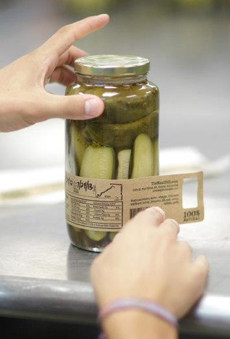
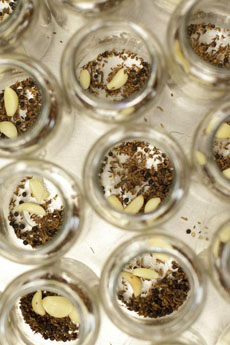
Start with a clean jar and seasonings. Photo courtesy The Real Dill | Rachel Kemble Photography.
|
STEPHANIE ZONIE is a contributing editor at THE NIBBLE.
|
|
November 2013
Last Updated December 2013
|
 |
How Pickles Are Made
Page 5: Brine Or Fermentation
This is Page 5 of a seven-page article about making pickles, plus six pages of reviews of artisan pickle brands. Click on the black links below to visit other pages.
How Are Pickles Made?
That depends entirely on which kind you choose. Two of the three basic types use an acidic vinegar-based brine and either refrigeration or pasteurization to kill bacteria. The third type, however, is very different.
Refrigerator Pickles. Also called quick pickles, this is the type most likely to be made in a home kitchen. Cucumbers are cut or chopped or sliced as desired, then packed into clean jars. A brine containing vinegar, water, salt and other seasoning and flavoring ingredients is typically brought to a boil before being poured over the cucumbers. Once the jar contents have cooled, the jars are closed tightly and placed in the refrigerator. Depending upon your recipe and source, they may be ready in as little as two days, or it may take as long as three weeks for the flavors to truly blend. These pickles must be kept refrigerated. |
|
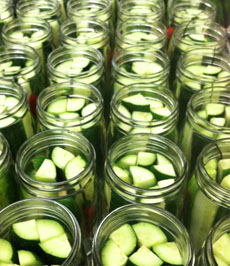
Next, add the cucumbers. Photo courtesy Gordy’s Pickle Jar. |
Fresh-Packed or Quick Process. These pickles, too, use a vinegar-based brine with salt and seasonings/flavorings. Once the pickles are packed into their jars with the brine and other ingredients, they are pasteurized, allowing for a lengthy shelf-life. This is the most common type of commercially-available pickle. Michael Pollan, in his book Cooked: A Natural History of Transformation, argues that both Refrigerator Pickles and Fresh-Packed pickles are not truly pickled at all. Instead, they are soured, marinated in vinegar. While vinegar itself is a product of fermentation, almost all of the vinegar used in such pickles is also pasteurized. |
|
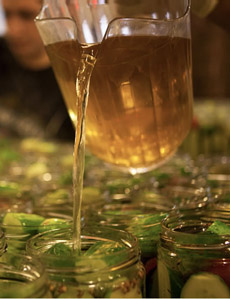
Pour in the brine. Photo courtesy Brooklyn Pickle Co. |
Fermented or Processed Pickles. Also known as true fermented, lactic acid fermented or lacto-fermented pickles. This was the original pickling process. Vegetables are washed, chopped or sliced as desired, and combined with a salt brine (salt and water) and other seasonings. The salt draws out the juices, preserves the cucumbers while the fermentation gets going, and, along with storage temperature, regulates the fermentation. The vegetables are packed into air-tight storage vessels (often barrels or crocks) and placed in an area where the temperature ranges from roughly 65 to 80 degrees Fahrenheit. Cucumbers require about one week of fermentation to become pickles, although other vegetables take more time to mature. You can find more details here. |
|
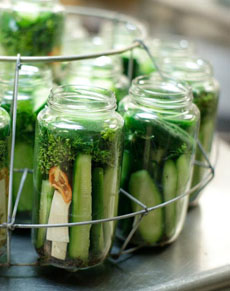
For shelf-stable pickles, get ready to sterilize. Photo courtesy The Real Dill | Rachel Kemble Photography. |

|








